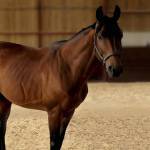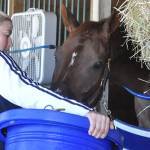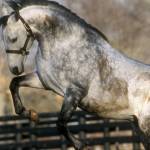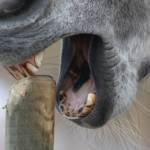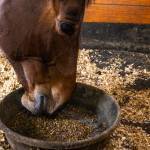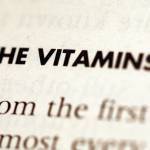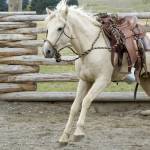Unraveling Mysteries of New Neurologic Disease in Quarter Horses
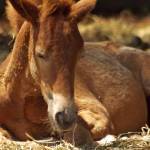
A neurologic disease affecting Quarter Horse foals less than one month of age was first identified in 2020. Since then, data collected from 12 affected foals show that the disease is distinct from other neurologic diseases of Quarter Horses and is likely a recessive genetic condition.* The condition is called equine juvenile spinocerebellar ataxia (EJSCA).
Affected foals present with asymmetric ataxia affecting the hind limbs worse than the forelimbs. This means the foals are uncoordinated and appear worse on one side of the body than the other.
The disease is progressive. Foals develop an abnormal gait in the forelimbs so they appear to be high-stepping, a classic feature of damage to a part of the brain called the cerebellum. Ultimately and unfailingly, foals become recumbent and require humane euthanasia, according to the report.
Bloodwork from the 12 foals was largely normal, except for an increase in glucose and a liver enzyme called gamma-glutamyl transferase. Microscopic analyses of the foals’ nervous tissues postmortem show distinct changes in the structure of the nerve cells referred to as “dilated myelin sheaths.”
In addition, six generations of pedigree data were analyzed for all 12 foals. Six foals shared a sire, and all 12 foals were related on the sire side within four to five generations. All foals were related within four to six generations on the dam side.
“EJSCA appears to be an autosomal recessive trait, which is the same mode of inheritance as hereditary equine regional dermal asthenia (HERDA) in Quarter Horses,” described Ashley Fowler, Ph.D., a nutritionist for Kentucky Equine Research.
Originally, veterinarians were suspicious that these 12 foals instead had equine neuroxonal dystrophy/equine degenerative myeloencephalopathy (eNAD/EDM), spinal abscesses, a bone infection (osteomyelitis), trauma, or a congenital condition.
“A neurologic disease of young Quarter Horses, eNAD/EDM is caused by a genetic predisposition and vitamin E deficiency. Signs of this condition can initially seem similar to EJSCA, but animals with eNAD/EDM have symmetric ataxia and decreased vitamin E levels in the bloodstream. In foals with EJSCA, the vitamin E levels were not deficient when measured,” Fowler explained.
She added, “No effective treatment has been identified for either eNAD/EDM or EJSCA, but the risk of the foal developing clinical signs of eNAD/EDM is reduced if the mare is supplemented with vitamin E during pregnancy and the foal receives adequate vitamin E after birth.”
The average-sized adult horse (500 kg or 1,100 lb) requires a minimum of 500 IU of dietary vitamin E per day (1 IU/kg of body weight), but horses with eNAD/EDM should receive 10 IU of vitamin E per kilogram of body weight. This means a pregnant mare should receive 5,000 IU of vitamin E and the foal should receive 500 IU, with amounts increasing by 10 IU/kg of weight gain.
“Using natural-source, water-dispersible vitamin E is the quickest and most effective way to increase serum vitamin E levels,” advised Fowler.
Nano-E is a rapidly absorbed, water-dispersible, natural source of vitamin E that uses nanotechnology. Each milliliter delivers 250 IU d-alpha-tocopherol that can be top-dressed for easy administration.
For EJSCA, veterinarians experienced with this condition said, “Further genetic investigation is warranted to identify an underlying causative variant(s). Once the causative variant(s) for EJSCA is validated, carriers can be identified through genetic testing to inform breeding decisions.”
*Willis, A.T., A.R. Dahlgren, K.D. Woolard, et al. Clinicopathological and pedigree investigation of a novel spinocerebellar neurological disease in juvenile Quarter Horses in North America. Journal of Veterinary Internal Medicine 38(3):1808-1814.

